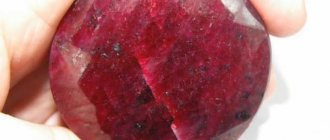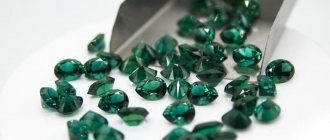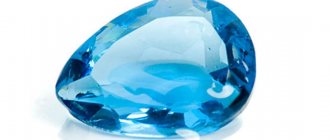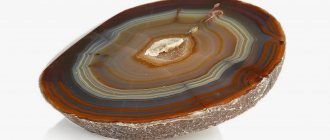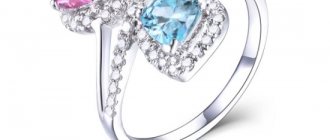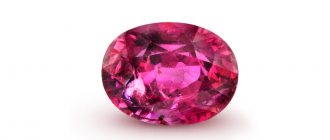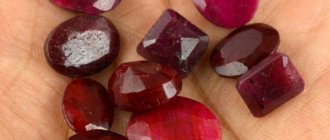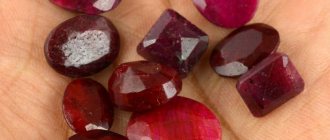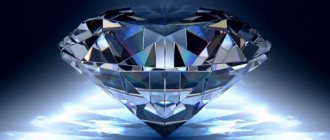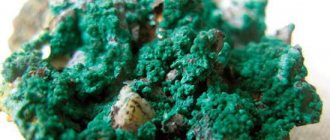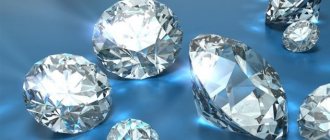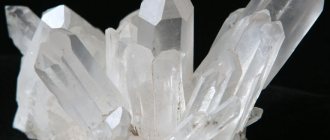| Property | Description |
| Formula | Al2O3 |
| Impurity | Cr |
| Hardness | 9 |
| Density | 3.99-4.10 g/cm³ |
| Refractive index | 1,763-1,772 |
| Kink | Conchoidal |
| singonia | Trigonal |
| Cleavage | Imperfect |
| Shine | Glass |
| Transparency | Transparent |
| Color | Red, red-brown, red-purple, red-pink. |
Colors and varieties
The main color of the mineral is blood red. The stone can also be fiery crimson, red-brown, yellowish-red, red-pink. The most valuable gem is one that has bluish or purple hues, the so-called “pigeon’s blood” colored stone.
Uncut ruby
Ruby is very close in composition to sapphire, which is also corundum (aluminum oxide), but does not have such a rich range of colors as its relative, therefore, if suddenly someone somewhere hears about a pink or green ruby, then most likely , we will talk specifically about sapphire. However, pink ruby still exists. This is a young natural gem of light pink or lilac shades.
Pink ruby ring
A star ruby is essentially a sapphire and can be any color. Its value lies in the shining six-rayed star located in the center of the processed stone.
Star ruby
A variety of ruby is anionite, a unique rock consisting of green cyosite with inclusions of dark pink or dark red ruby. The mineral is valued due to its amazing pattern, as well as the combination of colors created by the two rocks in this beautiful creation, the cost of which is very high.
Aniolite
The color and quality of a ruby depend on its deposit.
Ruby: properties and history of the gemstone
Ruby
One of the most sought after gemstones today was known thousands of years ago.
Then people did not know how to distinguish minerals of similar color, classifying all red minerals as rubies. The ancient Indians considered it the stone of the Sun and called it nothing more than “the leader of gems.” In European countries, ruby was the patron of the brave and courageous, knights devoted to ideals. In the countries of the East, the red stone was considered the blood of the Dragon and symbolized vital energy, bringing strength, love and health.
Properties of the stone
Ruby is one of the varieties of red corundum. The shade of the mineral varies from bright pink to deep red and depends on the amount of chromium impurities. The most valuable and rare corundums are considered to be “the color of pigeon’s blood”, which have a purple tint.
Ruby is a first category gemstone and its composition is similar to sapphire. This mineral is second only to diamond in strength. Ruby has a hardness rating of 9 on the Mohs scale.
Red corundum crystals have a high degree of transparency and luster. No other precious mineral has such characteristics except diamond. Thanks to these properties, a large ruby can cost even more than a similar-sized diamond.
In appearance, a ruby resembles a red spinel and is sometimes distinguishable from it only under a microscope. Also, red corundum can be easily confused with garnet, hyacinth zircon, topaz and tourmaline.
Minerals with rutile inclusions, similar to stars, are of high value. Such stones are very rare and therefore expensive.
In the mid-19th century, a method for producing artificial rubies was discovered. Currently, artificial red corundum is used in the manufacture of watches and jewelry, as well as in quantum electronics as a laser element.
How to determine the quality of a ruby
The cost of a natural ruby is quite high, so there is no need to rush when purchasing jewelry with this precious stone.
Centuries later, even some royal regalia rubies are being “exposed.” Thus, as a result of modern research, fake rubies were discovered in jewelry belonging to the royal family of England. The famous "Black Prince's Ruby" adorning the British crown turned out to be just a red spinel. What can we say about our time? However, there are three ways to help you determine the quality of a mineral.
1 way. When buying jewelry with a ruby, be sure to look at the stone not only in artificial light, but also in daylight. Good quality rubies have almost the same hue in any light, while lesser quality rubies turn pale pink in daylight.
Method 2. Examine the stone under a magnifying glass. Natural corundum has inclusions and small imperfections, while synthetic stones appear clear, like glass.
3 way. Add lemon juice to the corundum. If the stone is real, it will remain unchanged. Otherwise, cloudy inclusions will appear on the stone.
Mining rubies
There are many deposits of rubies. Red corundum is not mined except in Antarctica. But only 1% of the mined minerals are of jewelry quality.
Until now, rubies are mined using ancient technologies known for many hundreds of years. This labor-intensive process is carried out manually by washing sand and pebbles. Often stones are taken directly from the bottom of rivers.
Rubies of Asian origin are of great value. Burma is considered the oldest deposit. It is Burmese rubies that are valued above others due to their rare coloring. Indian ruby placers are also known, which are also considered very ancient. For many centuries, these stones were used to inlay jewelry of high society.
Now, in addition to India and Burma, the main exporters of red corundum are Thailand, Sri Lanka, Tanzania, Tajikistan and Afghanistan. In Russia, this stone is mined only in the Polar Urals.
Thai rubies have a brownish tint. They are mined in Changvad at a depth of 8 meters. Corundums mined in Sri Lanka are usually a bright strawberry color. Locals call these stones "illam"
Medicinal properties
The healing properties of ruby in folk medicine have been known since ancient times. Healers often used water infused into the stone, not just the stone itself. It was believed that the larger the ruby, the stronger the healing effect of the water in which it was located. It was believed to be able to stop bleeding, cure plague and epilepsy. Because of its color, it was believed that it had a beneficial effect on the condition of the blood. In India it was believed that it was able to heal leprosy and epilepsy, plague and scabies, paralysis, and bile. In European countries, a sick stomach and impotence were treated with powdered stones mixed with water. If stones are placed on sore spots, diseases of the throat, ear, joints and spine can be cured.
This mineral strengthens the immune system, the heart, improves appetite, restores strength, has a good effect on blood vessels, gas accumulation, relieves depression, and reliably protects its owner from injuries and serious illnesses. It also treats neuroses and depression, helps cope with boredom and melancholy, misfortune and sadness, anxiety and nightmares.
Place of Birth
Raw ruby crystal, length about 2 cm.
Apart from Antarctica, ruby is found on all continents.
The main ruby exporting countries are Myanmar, Thailand and Sri Lanka. Rubies from East Africa, from countries such as Kenya and Tanzania, are also in demand.
Since ancient times it has been mined in the Pamirs (Snezhnoye deposit in Tajikistan).
In Russia it does not form independent deposits, but is found only as a rare associated material in corundum deposits: the Southern Urals (Marble Log), Northern Karelia (Hit-Ostrov), the Kola Peninsula (Mount Peruselka), the Polar Urals (Rai-Iz).
Magical properties of ruby
Star Ruby Jewelry
This red gem is a stone of power. It has always been worn by people who have reached a high position, on whom the position of other people depends.
Esotericists have long believed that the magic of a ruby does not change a person. It only strengthens his character traits - both good and bad. Here the meaning of the stone is to be a catalyst for human qualities.
Therefore, a person with evil thoughts should not wear items made of red ruby. In this regard, the stone is “unprincipled”; it always indulges the passions of its owner. Whether it’s passionate love or the same passionate desire to ruin a rival by any means, to harm a rival... It’s better not to wish harm on your neighbors (and those far away too).
- Ruby is a stone of brilliance and vanity, pride and creative success.
- But these magical properties of the stone can energetically devastate the owner.
- Active, energetic people will find a harmonious ally in the gem.
- Ruby, its fiery color carries the symbolism of love, passion and fidelity.
- The magical properties of ruby protect the owner of the stone from evil forces and from astral attacks.
- If the color or shine of a gem has changed, this means you should be wary. These are signs of possible danger.
- Dedicated magicians love ruby - the stone gives them strength and power over the lower astral plane.
- Fire is the element of ruby. And the flames of passions are subject to the flame-colored stone.
- It is important to know that ruby is a symbol of love, but carnal love.
This is interesting!
Some esotericists believe that the property of ruby (lonely) is to attract loneliness. That is why it is recommended to wear rubies in pairs.
All properties apply only to real gems.
Medicinal properties
Uncut ruby
Lithotherapists of our time have described the following healing capabilities of ruby:
- improving the functioning of the immune system;
- wound healing;
- improving blood flow, heart function, improving blood pressure, toning blood vessels;
- improvement of brain functions;
- sedative for stress or depression;
- assistance in the treatment of paralysis, epilepsy, schizophrenia;
- treatment of joint diseases;
- elimination of problems of the digestive system, in particular, treatment of stomach ulcers.
Ruby is considered a hemostatic agent. It also has an antipyretic effect, relieves bad dreams, cures chronic tonsillitis, diseases of the kidneys, liver and spine.
Did you know that medieval Aesculapians used ruby to treat the plague?
A sunbeam passed through a ruby is endowed with healing powers. Healers claim that such light has a positive effect on metabolism, restores tissue, and has an anti-inflammatory effect.
Important!
People suffering from hypertension (high blood pressure) or blood incoagulability (hemophilia) are contraindicated from wearing a ruby!
Ruby-charged water is an effective way to maintain beauty and health. To do this, leave the gem in water overnight, and then drink the liquid or wash it with it. This technique helps to quickly recover from stress, restore strength after illness, or simply maintain natural beauty.
Ruby history
It is believed that rubies have been known to man since the Bronze Age. In India, even before our era, they were called the kings of precious stones and were often used in talismans. The Romans and Greeks also appreciated the beauty of this precious stone. Ruby became a frequent companion of royalty and nobility.
The word “corundum,” however, is somewhat modified, and came to us from the people who inhabited Southeast Asia in ancient times. This is what they called the opaque grayish stones of exceptional hardness that were found in that region.
Advertising - Continued below
In Rus' in the Middle Ages it was called yakhont and was credited with protection from bad dreams.
Talismans and amulets
Faceted ruby
The stone is an excellent amulet and amulet for military personnel and firefighters, protecting them from death. It warns owners of danger by changing its color.
It is believed that the ruby talisman will protect against natural disasters and negative magical effects. If you have a ruby crystal in your house, it will protect your home from fire and thieves.
If you wear a stone amulet constantly, then good luck will always accompany its owner. Any situation, be it finances, health or work, will change for the better. The energy of the stone allows a person to strive for everything new and unknown, opening up vast horizons of possibilities. Such a talisman will help people of mental and creative professions, as well as those who love adventure.
A gem amulet can bring prophetic dreams. If a person dreams of a ruby, then good luck, success and prosperity await him in life.
Compatibility with Zodiac signs
Ruby is most suitable for Cancers and Geminis. It helps them become more confident and balanced. The stone also improves their relationships with others and helps in love affairs. An amulet made from this material will be useful for other zodiac signs:
- Leo (makes the wearer more charming);
- Sagittarius (helps to get rid of arrogance and develop determination);
- Aries (calms, allowing you to make more thoughtful decisions);
- Capricorn (increases activity and cheerfulness);
- Scorpio (promotes compliance, reduces conflict).
The energy of Taurus and Virgo is completely incompatible with ruby. The mineral will make such an owner unsociable and aggressive. Therefore, wearing jewelry made from this material is highly discouraged for Virgos and Taurus.
Compatibility with other stones
Ruby has strong energy and can weaken the effects of other minerals. In addition, it is an aggressive stone. Therefore, if the combination is incorrect, there is a risk of a noticeable deterioration in the physical and psychological health of the wearer. Ruby can be worn with the following stones:
- turquoise;
- emerald;
- White pearls;
- sapphire;
- alabaster;
- amethyst;
- agate;
- beryl;
- lapis lazuli;
- coral;
- cornelian.
It is prohibited to wear this gem with onyx and malachite. Ruby also has a bad relationship with obsidian, opal and rock crystal.
Areas of application of ruby
- Synthetic ruby was used as the light-emitting active medium in the first laser, created in 1960 by Theodore Maiman. Synthetic ruby lasers continue to be produced and used to this day.
- A category I gemstone, used in expensive jewelry.
- Synthetic corundums called “rubies” are used in the jewelry industry for inserts in inexpensive products and as “stones” in watch movements.
Ruby products and jewelry
Ruby ring
Ruby is widely used in jewelry. Absolutely all jewelry can be decorated with it: rings, earrings, bracelets, rings, necklaces, necklaces, etc.
Every girl or woman will be pleased with exquisite ruby jewelry, of which there is such a variety that you can satisfy even the most demanding taste.
A ruby in silver looks most luxurious. This noble metal allows the mysterious and bewitching stone to fully reveal itself.
The silver ring with a ruby is especially chic. If it is intended for everyday wear, then it is better to choose a thin ring that will look stylish and modest, and for going out in public, massive rings with large rubies of dark and rich colors of an exclusive cut are suitable.
Ruby in silver fits perfectly into any style and image, and is suitable for both stylish and business women, as well as sensual beauties. Absolutely everyone - both blondes and brunettes - will be able to choose a piece of jewelry to their liking.
For an engagement, you should choose a gold ring with a ruby, as it is a symbol of fiery love and devotion. Such a ring will support the fire of feelings and will not allow love and passion to go out for a long time.
Crystal Care
For all its hardness, ruby is a fragile stone. It is necessary to protect ruby products from falling or hitting hard surfaces.
But ruby is able to scratch other gems - its hardness is second only to that of diamond. Therefore, a separate house - a case or bag made of dense soft fabric - is suitable for decoration. Rubies do not like to be exposed to the hot sun for long periods of time, so store them in the dark and avoid wearing jewelry with these stones in hot countries.
Cleaning at home is simple:
- If your jewelry is dirty, dilute baby soap in warm water and carefully rinse the stone in this solution. Use a used (not hard) toothbrush or just a napkin. Rinse the jewelry and wipe gently with a dry cloth.
- If you are going to work with your hands, remove the ruby ring. Household chemicals are not at all beneficial for gems.
- It is better to take heavily soiled jewelry to a jeweler, he will clean it using special methods and means.
We recommend: GARNET - a stone of passion and love, blood and flame
Interesting: choose a place to store ruby jewelry in the southern part of the house. According to Feng Shui, this will increase the social status of the family in general and the owner in particular.
How much can a ruby cost?
Gold earrings with rubies
The value of a ruby is determined by the following parameters:
- color of the stone - the richer and brighter, the better;
- structure - cracks, darkening or bubbles reduce the price;
- weight - a carat of a large specimen is more expensive than a carat of a small one;
- cut - if the lower segment is larger than the upper, the stone is more expensive;
- inclusions reduce the price, but a uniform soft “silk” in a transparent crystal (no frills) is welcome.
Rubies, as high-class stones, are sold at auctions.
A certificate for a ruby purchased at a salon must indicate whether the stone has been refined or is 100% natural. Most salons or online stores sell synthetic or heated rubies.
Natural stone of rich, bright color is very rare in nature. The cost of the most valuable pigeon's blood ruby is from $50,000 per carat.
Cost table:
| Stone quality, carat weight | How much is a carat of ruby worth in US dollars? |
| Commercial quality, per 1 carat | 600-6 000 |
| Premium quality, 1-2 carat stones | 1500-17 000 |
| Premium quality, stones 4-5 carats | 6 000-32 000 |
| Top quality, 1-2 carat stones | 12 000-25 000 |
| Top quality, weighing 4-5 carats | 40 000-60 000 |
Most jewelry stores offer items made of silver or gold of the lowest standard with heated rubies or even artificial ones, which a person with average income can afford. Prices for such jewelry are several times lower than the cost of elite products:
- A budget ring made of sterling silver or 14k gold with an artificial stone starts at $200. A natural heated ruby will cost several times more;
- earrings of similar quality cost from $300;
- pendants will cost an average of $300-500;
- the bracelet costs from $900.
Physics and chemistry of crystal
Characteristics of rubies:
- hardness 9 on the Mohs scale (only diamond is harder);
- dash color is white;
- the color of the stone is from pink-red to red-purple, with violet tones;
- glass shine;
- chemical formula Al2O3 (class of oxides) with an admixture of chromium.
Ruby is a stone of the first (highest) group of the first order according to the Russian classification.
The colors of rubies range from pink to red-black. The most “correct” ruby is “the color of pigeon blood.” This is a bright red color with a purple tint. Such crystals are extremely rare.
A gem with an asterism effect is considered very valuable. They contain rutile inclusions, which cause a “star in the stone” effect.
Artificial ruby
Synthetic pink rubies
Natural stone is available only to a few, so technologies for producing an analogue have been developed. This is the first gem reproduced by people.
Ruby crystals are grown in several ways. The most popular is the Verneuil method. The Frenchman obtained “Siamese rubies” by fusing ruby powder. In three hours, a 30-carat synthetic stone is obtained. It looks natural.
In the 20th century, new methods for producing artificial crystals appeared:
- Czochralski and zone melting methods, crystallization from solutions in the melt or from the gas phase;
- hydrothermal method.
Latest most popular:
- cheap minerals are mixed with additives and melted;
- the mass is crystallized under a set pressure and at high temperature;
- Large stones are formed; their composition and properties are identical to natural ones.
Such rubies are called hydrothermal.
All rubies in Soviet jewelry from jewelry stores are artificial.
"Timur's Ruby"
The most famous, perhaps, is the so-called “Ruby of Timur”, the history of which, with some gaps, can be traced over the past six centuries. Many of its owners can be judged by the corresponding inscriptions on this extraordinary stone the size of a chicken egg. There are many famous names here: Sahib Kiran Sani (as Tamerlane was called in the Muslim world), his grandson Ulugbek, the rulers of the Mughal Empire Akbar, Jahangir, Aurangzeb and Shah Jahan, associated in our memory with the pearl of Indian architecture - the white marble Taj Mahal. In 1849, the East India Company took possession of the stone. In 1848 - Queen Victoria, kept in the Indian Room of Buckingham Palace. However, the “Ruby of Timur” turned out to be not red corundum at all, but a less hard and not so valuable stone - spinel, but this was established only in 1851. As of February 2009, the Ulugbek ruby, similar to the “Ruby of Timur,” belongs to Sheikh Nasser al-Sabah of Kuwait.
How to distinguish an original from a fake
ring
is very expensive, so fakes often appear on the market. To check the authenticity of a gem at home or when purchasing, you can see what a ruby looks like under a magnifying glass.
Nature is a strict mother, so genuine stones formed in the bowels of the earth are very rarely perfect; you can see small air bubbles, foreign inclusions, cracks, and abrasions in them. There are other ways to expose scammers.
- In the old days, the authenticity of red corundum was checked by placing it in a container of milk. If the crystal is real, it turns pinkish.
- It is very difficult to imitate the play of light. Natural crystal will refract the sun's rays. If you look at it from different angles, the shade will change slightly.
- The crudest fakes made of glass or plastic can be identified by clenching them in your fist. The genuine gem will remain cold, the glass will heat up. But an artificial stone grown in a laboratory will pass such a test.
- If you put the crystal in a glass, it will glow pink. When ultraviolet rays are shined on it, the stone turns orange.
When purchasing, it is important to remember that only genuine minerals have magical and healing properties. A synthetic ruby grown in a laboratory is useless as a talisman. A piece of plastic or glass - even more so.
Jewelry with rubies
The gem is most often used to create rings and earrings. Less commonly it can be found in necklaces, pendants, bracelets and brooches. The mineral is often complemented with other precious stones such as diamond, sapphire, emerald or amethyst. The setting may vary depending on the quality of the ruby:
- platinum;
- gold (750 standard or with a lower quality stone - 585);
- Sterling Silver).
The most common frames are yellow or white gold. The size and number of rubies in a piece of jewelry can vary greatly. Specimens with single large stones are relatively common.
How to wear and care
When choosing jewelry, it is worth considering that the mineral is not suitable for every style of clothing. A large number of rubies, especially in yellow gold, makes the wearer too bright and noticeable. Therefore, it is better to limit yourself to wearing one or two products made from this material. Ruby, due to its rich red color, may not match well with the owner's hair and eye color. The most versatile option is considered to be stones of pale shades in a silver frame.
It is important to understand that, despite the hardness of this type of corundum, the surface of the stone can be damaged when struck by blunt objects. Therefore, you should avoid wearing jewelry while playing sports, doing household chores, or gardening. To prevent the stone from losing color and cracking, you need to pay attention to the list of care rules:
- Cleaning. This is done using soap and water. In this case, small items are soaked in a light soap solution, and large ones are cleaned with a cloth or soft brush. There is another safe cleaning method - ultrasonic. Although highly effective, this method has several limitations. Firstly, if the product contains not only ruby, but also softer stones, then such cleaning is prohibited. Ultrasonic cleaning can also weaken some types of frames. This method should not be used if the ruby is colored or has a filled crack.
- Exposure to chemicals. Although the stone does not dissolve in acids, they can accumulate on its surface. This makes the surface of the gem cloudy and faded.
- Storage. It is not recommended to store the mineral in conditions of high humidity. Shared storage with other stones is allowed, but only when wrapped in soft cloth or a plastic bag. This is justified by the fact that ruby can easily scratch other minerals that do not have such high hardness.
- Filled cracks. Gems with hidden defects require special attention. Often cracks are filled with ordinary glass. Such products have increased sensitivity to acids, ultrasound, shock, and hard brushes. To damage such a stone, it is enough to get tomato juice on the surface of the product.
- Fastenings. No matter how durable a ruby is, its setting can be damaged. If the fastenings are damaged, the jewelry must be taken to a jeweler. Otherwise, the precious mineral risks falling out of the frame, especially with sudden movements and impacts.
With constant wear, it is extremely important to periodically check the condition of the stone. Ruby does not lose color when exposed to sunlight or sweat, but large amounts of dust can damage the surface.
How to distinguish from a fake
The mineral can be replaced with ordinary glass, cheaper stones or synthetic rubies. The latter are almost impossible to distinguish. To distinguish a fake, you should pay attention to the following natural features of the gem:
- the color, shine and transparency of the stone change depending on the lighting;
- placed in any glass vessel, a ruby begins to glow;
- the milk in which this stone is located takes on a pink tint;
- under ultraviolet light, a real gem acquires an orange color;
- bubbles, cracks and scratches on the stone should not have smooth boundaries;
- A natural ruby weighs more than its artificial counterpart.
This variety of corundum is also distinguished by the fact that it heats up very slowly in the hands. It should be borne in mind that they most often try to replace ruby with garnet. The difference lies in the shine - garnet has a matte finish, which is especially noticeable in the sun.
FAKE GLASS
Who suits the name
Jewelry with ruby
Ruby favors those who are called by the following names:
- Allah. The stone will awaken pure thoughts in her, but will also bring trials into her life to achieve them.
- Benjamin. Ruby will help him improve leadership skills, determination, and a sense of responsibility, eliminating uncertainty and sad thoughts.
- Varvara. For such a girl, the gem will become a love talisman, bringing happiness in matters of the heart.
- Pavel will be able to overcome his complexes, gain leadership qualities, and become responsible with a ruby amulet.
- Faith will gain strength and confidence to achieve your goals. Ruby will help this girl gain recognition, fame, and will also protect family happiness, protect her from troubles and troubles.
- Victor will strengthen his characteristic sense of purpose, dignity and courage. And also the ruby will relieve him of fears and worries.
It must be remembered that ruby helps only those who know what they want to achieve. When the owner goes to the goal according to the principle “all means are good”, the stone will “teach” such a person a lesson, contributing to the loss of everything accumulated. This is worth considering when choosing a talisman.
Who will benefit from the stone?
Sunrise ruby weighing 25.59 carats in a ring from Cartier.
Photo: Sotheby's auction house Ruby is suitable for leaders by nature - it is a stone of strong and persistent people who are ready to fight to achieve their goals. However, it is worth remembering that ruby is not a help to spoiled and vain people.
Ruby will help those looking for love, as well as those who are afraid to believe and take the first step. If the heart and soul of the owner are pure and sincere, this stone will become the best talisman on the path to great accomplishments and achievements.
